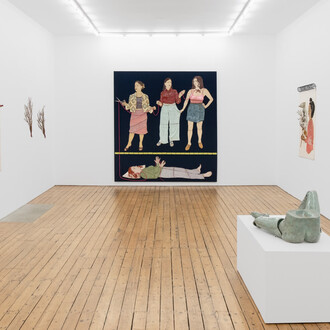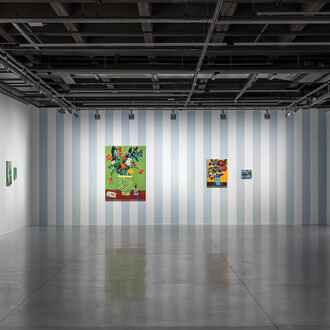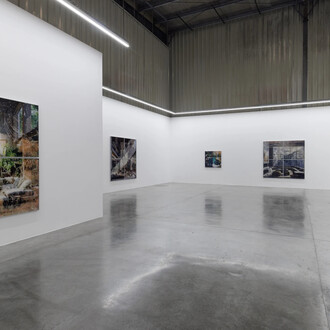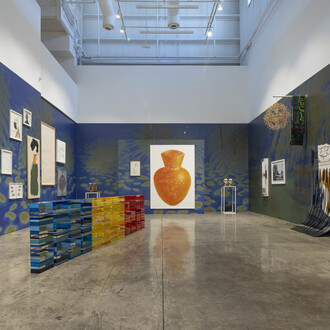VITRINE Gallery in Bermondsey, London was opened in 2012: the result of a successful and vibrant project space in the same location launched by Alys Williams in 2010. She then went on to found VITRINE in Basel in April 2016. An important mission for the VITRINE Gallery was to create a platform that included commissioned sculptural work. The SCULPTURE AT programme became a reality and a series of public sculptures were scheduled for display in London’s Bermondsey Square.
SCULPTURE AT offers artists a commissioning opportunity to make work in the public realm, regardless of whether they have past public commission experience. This is a unique opportunity to create ‘temporary’ public sculpture, which differs greatly to permanent commissions in concept and realisation. Alys believes that there is greater creative freedom in this temporality. It allows for a growing dialogue between the commissioned artists and the gallery as it offers an important diverse platform that enables new work to evolve.
Alys’ interest stems from an exploration of ‘installation’, which later became more engaged with non ‘white cube’ spaces. This organic journey was how VITRINE became a reality and is core to the curation of the programming still today. However, SCULPTURE AT has a role over and above that of being a platform for artists. As Alys says:
“There is much division in our communities. Both in the way many visitors (not in the art world) feel intimidated to go into a gallery, and in the way public commissioning bodies often go to the same pool of artists with past experience in this realm. With SCULPTURE AT we wanted to break the boundaries in both these areas down”
A development of this principle was the partnership with sculptor Lucy Tomlins, whose work was spotted for the first time at the Royal College of Art in her final degree show. Her bold sculptures stood out then, but it was only when Alys met her several years later through a partnership with the Pangaea Sculptors' Centre that Lucy co-founded, that a collaboration was developed for the SCULPTURE AT programme.
‘Pylon and Pier’ was the result of this partnership and for Alys this work held a very strong and current message. Lucy took the public square as the work’s starting point. Traditionally this is where statues of distinguished people are sited, usually placed there to reinforce notions of power or national prestige. ‘Pylon and Pier’ reverses this however, presenting a statue of the Titan Atlas. Not as in Greek mythology holding up the sky for eternity, but fallen from his plinth and, grasping the globe, lain on his side. The piece can be read as a commentary on the current politic situation in Britain, yet there is a historical aspect to the scene. Traditionally a public square is where statues of distinguished people are sited. Because of the scale of their environment, public sculptures designed to look life-size are actually usually created at 1 and 1/3rd life-size. They are made to look greater than life-size to increase this distance between the public audience and the person they are looking up at, reinforcing notions of power or national prestige.
For Lucy this commission was a perfect opportunity to continue her love for making work outside the white cube environment where the very essence of the work is an outcome of the interplay between form, material and the world in its proximity. As a sculptor, Lucy feels that you can’t help but be very conscious of the situation and location where the work is being displayed, whether it is a white box gallery, a forest or a cathedral. They all come embedded with their own histories, and with formal and architectural qualities to be read against and through the work. Sculpture is by its very nature engrained in the here and now through their physical presence in time and space. The commission requesting work to be made for new contexts and in different public spaces is therefore interesting and challenging to Lucy.
In addition to this Lucy is also interested in making work that is appealing to both an art and non-art audience, the opportunity to create work for public space offers access to a wide and diverse audience.
“My artwork is firmly rooted in the everyday and often uses imagery directly referential to the material objects of our society which are easily recognisable. Food is a recurring visual theme in my work for this reason; something we all have a relationship with and can relate to. This is in part so it is attractive and accessible to a wide audience, not just an art audience. So on first looking it seems familiar to people through the use of everyday and known imagery. However, on closer inspection the artwork offers further layers of complexity. The formal and material transformative decisions and juxtapositions play with uncanny relationships between seemingly disparate materials and things. These changes from what might be expected or already known of these readymade ‘things’ by the viewer, act as points of difference that, through the phenomenological encounter, enable a reflection back onto the original known object and a relooking of the world around them”
Unlike previous works the challenge to the notion of power and prestige that comes through Pylon and Pier is a new exploration for Lucy. It came out via the site and the time specificity of the piece. The commonality with previous works is the situation and social reflections explored, which have previously ranged from diverse topics such as consumption and desire; over production and commodification; the handmade versus the mass-produced; euphoria, religion and tribal power.
In this way there is an unavoidable indication of social commentary within Lucy’s work and it is perhaps not unusual for Pylon and Pier to respond to the current political context. Lucy felt that any artwork displayed in the public context of a square in Bermondsey, London, at this juncture, automatically resonates with the socio-political context we find ourselves in including the dramatic results of the Brexit vote, the Middle Eastern conflicts, global terror attacks and the results of the American presidential election.
“The toppling of statues in public squares across the globe appear in the media as symbols of revolution and power shifts, of overthrown governments. ISIS uses social media to spread imagery of the vandalism and destruction of ancient artworks and artefacts in their attempt to erase history and our connection with the past and traditions. Did he fall or was he toppled? The sculpture depicts a fallen statue of the Greek Titan Atlas. In such turbulent, catastrophic times the burden of supporting the weight of the world on his shoulders has become too much”
Artists and creatives have a freedom of expression and a public platform that is unique. For example, they haven’t had to sign a contract with a corporation binding them to keep public opinions politically neutral or tempered in case of upset to an important client of the company. Lucy believes that by choosing to follow the path that artists have, many are already attempting to find an alternative way of living within, and engaging, with the social system and perceived norms.
“I think what artists can do is present alternative viewpoints to the rhetoric more commonly presented in the media and make artwork that, without being didactic, offers its audience food for thought and encourage a reconsideration of the world around them”















